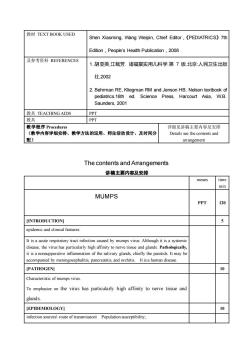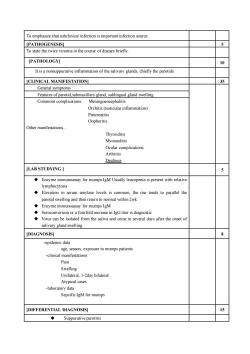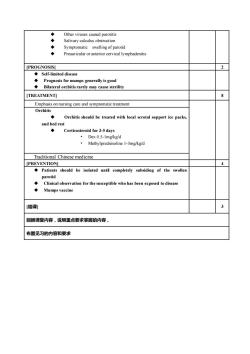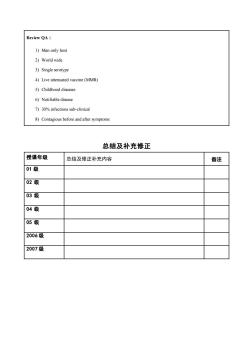《儿科学》课程教学资源(授课教案)24 Mumps

重庆医科大学儿科学教案小儿传染病一流行性腮腺炎教师:詹学授课题目TEACHINGTOPICMUMPS第几次课TIMES3th教学方法METHODSClass teaching教学对象OBJECTIVEInternational students in Grade 2007,2006, 2005学时:TIME120minutes授课目的PURPOSE1.To comprehend the characteristic of mumps virus, epidemiology anddiversify ofmumpsTo take the prehension in main points of diagnosis and clinical course oitypical mumps.3. To take the prehension in common complications and therapeutic principle.本课重点EMPHASIS1. the characteristic of epidemiology of measles around the world recently.clinical manifestationof mumpsdiagnosis and differentialdagnosisinmumpsthecommoncomplicationsofmump:本课难点DIFFICULTIESdiagnosis and differential diagnosis in mumps深化与拓宽Emphasis that is a nonsuppurative inflammation of the salivary glandshieflythe parotdsaditisaumadiseasThe developmentsEmphasis that etiology of mumps is mumps virusMumps virus is a member of the genus rubulavirus in theparamyviridaefamily,which is inthe samefamily with meaeb)There is only one serotype. Reinfection is extremely rare.The age of peak incidence is 5~9 years olddiagnosis and differential diagnosis in mumps:Emphasis ontheprevention英语要求All in EnglishParotitisEnglish requirementsSubmaxillaritisNeurotropicMeningoencephalitisOrchitis (testicular inflammation)pancreatit践性教学安排Clinically, combined with the patients to learn thele manifestations and LabClinical studyfeaturesTofind out thecaof mumps byhistorytakingdiscussthdiagnossi and differential
重庆医科大学儿科学教案 小儿传染病-流行性腮腺炎 教师:詹学 授课题目 TEACHING TOPIC MUMPS 第几次课 TIMES 3 th 教学方法 METHODS Class teaching 教学对象 OBJECTIVE International students in Grade 2007, 2006,2005, 学时: TIME 120 minutes 授课目的 PURPOSE 1.To comprehend the characteristic of mumps virus, epidemiology and diversify of mumps 2.To take the prehension in main points of diagnosis and clinical course of typical mumps. 3.To take the prehension in common complications and therapeutic principle. 本课重点 EMPHASIS 1. the characteristic of epidemiology of measles around the world recently. 2. clinical manifestation of mumps 3. diagnosis and differential diagnosis in mumps. 4. the common complications of mumps 本课难点 DIFFICULTIES diagnosis and differential diagnosis in mumps 深化与拓宽 The developments 1. Emphasis that is a nonsuppurative inflammation of the salivary glands, chiefly the parotids and it is a human disease. 2. Emphasis that etiology of mumps is mumps virus a) Mumps virus is a member of the genus rubulavirus in the paramyxoviridae family, which is in the same family with measles virus. b) There is only one serotype. Reinfection is extremely rare. . c) The age of peak incidence is 5~9 years old 3. diagnosis and differential diagnosis in mumps; 4. Emphasis on the prevention 英语要求 English requirements All in English Parotitis Submaxillaritis Neurotropic Meningoencephalitis Orchitis (testicular inflammation) pancreatitis 践性教学安排 Clinical study Clinically, combined with the patients to learn the manifestations and Lab features; To find out the cause of mumps by history taking; discuss the diagnossi and differential

教材 TEXTBOOKUSEDShen Xiaoming, Wang Weipin, Chief Editor ,《PEDIATRICS》 7thEdition,People's Health Publication,2008及参考资料REFERENCES1.胡亚美,江载芳,诸福棠实用儿科学.第7版.北京:人民卫生出版社,20022. Behrman RE, Kliegman RM and Jenson HB. Nelson textbook ofpediatrics.16th ed. Science Press, Harcourt Asia, W.B.Saunders, 2001教具TEACHINGAIDSPPT教具PPT教学程序Procedures详细见讲稿主要内容及安排(教学内容详细安排、教学方法的运用、师生活动设计、及时间分Details see the contents and配)arrangementThe contents and Arrangements讲稿主要内容及安排/timemeansminMUMPSPPT120INTRODUCTIONI5epidemic and clinical features:It is a acute respiratory tact infection caused by mumps virus Although it is a systemicdisease, the virus has particularly high affinity to nerve tissue and glands. Pathologically,tisanuppurativeifmmationof thesalivaryglandshiflythe parosImayaccompanied by meningocephalitis, pancreatitis, and orchitis.It is a human disease10[PATHOGEN)Characteristic of mumps virusTo emphasize on the virus has particularly high affinity to nerve tissue andglands.10EPIDEMIOLOGY)infectionourcesrouteoftransmissionPopulationsusceptibility
教材 TEXT BOOK USED Shen Xiaoming, Wang Weipin, Chief Editor,《PEDIATRICS》7th Edition,People’s Health Publication,2008 及参考资料 REFERENCES 1. 胡亚美,江载芳. 诸福棠实用儿科学.第 7 版.北京:人民卫生出版 社,2002 2. Behrman RE, Kliegman RM and Jenson HB. Nelson textbook of pediatrics.16th ed. Science Press, Harcourt Asia, W.B. Saunders, 2001 教具 TEACHING AIDS PPT 教具 PPT 教学程序 Procedures (教学内容详细安排、教学方法的运用、师生活动设计、及时间分 配) 详细见讲稿主要内容及安排 Details see the contents and arrangement The contents and Arrangements 讲稿主要内容及安排 means time min MUMPS PPT 120 [INTRODUCTION] 5 epidemic and clinical features: It is a acute respiratory tract infection caused by mumps virus. Although it is a systemic disease, the virus has particularly high affinity to nerve tissue and glands. Pathologically, it is a nonsuppurative inflammation of the salivary glands, chiefly the parotids. It may be accompanied by meningocephalitis, pancreatitis, and orchitis. It is a human disease. [PATHOGEN] 10 Characteristic of mumps virus. To emphasize on the virus has particularly high affinity to nerve tissue and glands. [EPIDEMIOLOGY] 10 infection sources\ route of transmission\ Population susceptibility;

Toemphasize that subclinicalinfection isimportant infection sourcePATHOGENESISI5To state the twice viremia in the course of diseaes briefly[PATHOLOGY]10Itisanonsuppurativeinflammationofthesalivaryglands,chieflytheparotdICLINICAL MANIFESTATION35General symptomsFearesparomaiaryglablinguagland swlinCommom complications:MeningoencephalitisOrchitis (testicular inflammation)PancreatitisOophoritisOther manifestations.ThyroiditisMyocarditisOcular complicationsArthritisDeafness[LAB STUDYING ]5Enzyme immunoassayfor mumps IgM Usually leucopenia is present with relativenphocvtosiElevation inserumamylaselevels is common, the rise tends to parallel theparotid swelling and then return to normal within 2wkEnzyme immunoassay for mumps IgMSeroconversion or a fourfold increase in IgG titer is diagnosticVirus can be isolated from the saliva and urine in several days after the onset ofsalivary gland swelling.(DIAGNOSIS)8-epidemic dataage, season, exposure to mumps patients-clinical manifestationsPainSwellingUnilateral, -2day bilateralAtypical cases-laboratory data SepcificIgMformumps15[DIFFERENTIAL DIAGNOSIS]Suppurative parotitis
To emphasize that subclinical infection is important infection source. [PATHOGENESIS] 5 To state the twice viremia in the course of diseaes briefly. [PATHOLOGY] 10 It is a nonsuppurative inflammation of the salivary glands, chiefly the parotids. [CLINICAL MANIFESTATION] 35 General symptoms Features of parotid,submaxillary gland, sublingual gland swelling Commom complications: Meningoencephalitis Orchitis (testicular inflammation) Pancreatitis Oophoritis Other manifestations. Thyroiditis Myocarditis Ocular complications Arthritis Deafness [LAB STUDYING ] 5 ◆ Enzyme immunoassay for mumps IgM Usually leucopenia is present with relative lymphocytosis ◆ Elevation in serum amylase levels is common, the rise tends to parallel the parotid swelling and then return to normal within 2wk ◆ Enzyme immunoassay for mumps IgM ◆ Seroconversion or a fourfold increase in IgG titer is diagnostic ◆ Virus can be isolated from the saliva and urine in several days after the onset of salivary gland swelling. [DIAGNOSIS] 8 -epidemic data age, season, exposure to mumps patients -clinical manifestations Pain Swelling Unilateral, 1-2day bilateral Atypical cases -laboratory data Sepcific IgM for mumps [DIFFERENTIAL DIAGNOSIS] 15 ◆ Suppurative parotitis

Other viruses caused parotitisSalivary calculus obstruction.Symptomatic swelling of parotidRiorcervical lymphadenitisPreauricularor antericPROGNOSIS)2 Self-litediseasePrognosis formumps generallyis goodBilateralorchitis rarelymaycausesterility[TREATMENT]8Emphasis on nursing care and symptomatic treatmenOrchitisOrchitis should be treated with local scrotal support ice packs,andbedrestCorticosteroid for 3-5 daysDex 0.5-1mg/kg/dMethylprednisoline 1-3mg/kg/dTraditional Chinese medicinePREVENTION4 Patients should be isolated until completely subsiding of the swollenparotidClinical observation for the susceptible who has been exposed to diseaseMumps vaccine[结课]回顾课堂内容,说明重点要求掌握的内容,布置见习的内容和要求
◆ Other viruses caused parotitis ◆ Salivary calculus obstruction ◆ Symptomatic swelling of parotid ◆ Preauricular or anterior cervical lymphadenitis [PROGNOSIS] 2 ◆ Self-limited disease ◆ Prognosis for mumps generally is good ◆ Bilateral orchitis rarely may cause sterility [TREATMENT] 8 Emphasis on nursing care and symptomatic treatment Orchitis ◆ Orchitis should be treated with local scrotal support ice packs, and bed rest ◆ Corticosteroid for 3-5 days • Dex 0.5-1mg/kg/d • Methylprednisoline 1-3mg/kg/d Traditional Chinese medicine [PREVENTION] 4 ◆ Patients should be isolated until completely subsiding of the swollen parotid ◆ Clinical observation for the susceptible who has been exposed to disease ◆ Mumps vaccine [结课] 3 回顾课堂内容,说明重点要求掌握的内容, 布置见习的内容和要求

Review QA :1) Man only host2) World wide3) Single serotype4) Live attenuated vaccine (MMR)5) Childhood diseases6) Notifiable disease7) 30% infections sub-clinica8)Contagous befreand afersympoms总结及补充修正授课年级总结及修正补充内容备注01级02 级03级04级05级2006级2007级
Review QA: 1) Man only host 2) World wide 3) Single serotype 4) Live attenuated vaccine (MMR) 5) Childhood diseases 6) Notifiable disease 7) 30% infections sub-clinical 8) Contagious before and after symptoms 总结及补充修正 授课年级 总结及修正补充内容 备注 01 级 02 级 03 级 04 级 05 级 2006 级 2007 级
按次数下载不扣除下载券;
注册用户24小时内重复下载只扣除一次;
顺序:VIP每日次数-->可用次数-->下载券;
- 《儿科学》课程教学资源(授课教案)22 Infantale Diarrhea and Fluid Therapy.doc
- 《儿科学》课程教学资源(授课教案)23 Infantile Hepatitis Syndrome.doc
- 《儿科学》课程教学资源(授课教案)25 Scarlet Fever.doc
- 《儿科学》课程教学资源(授课教案)01 Introduction of Pediatrics.doc
- 《儿科学》课程教学资源(授课教案)04 Neonatal Jaundice.doc
- 《儿科学》课程教学资源(授课教案)05 Neonatal Septicemia.doc
- 《儿科学》课程教学资源(授课教案)02 Growth and Development.doc
- 《儿科学》课程教学资源(授课教案)03 Nutrition During Childhood.doc
- 《儿科学》课程教学资源(授课教案)09 Haematopoiesis and Blood Cell Counts.doc
- 《儿科学》课程教学资源(授课教案)08 Congenital Heart Disease.doc
- 《儿科学》课程教学资源(授课教案)06 Hypoxic-ischemic Encephalopathy.doc
- 《儿科学》课程教学资源(授课教案)07 Bronchopneumonia.doc
- 《儿科学》课程教学大纲 Teaching Outline for Pediatrics Course(英文).pdf
- 《临床生物化学》课程教学资源(PPT课件)第十九章 自动临床生物化学分析仪的应用及评价.ppt
- 《临床生物化学》课程教学资源(PPT课件)第十八章 治疗药物浓度监测.ppt
- 《临床生物化学》课程教学资源(PPT课件)第十七章 妊娠的生物化学检验.ppt
- 《临床生物化学》课程教学资源(PPT课件)第十六章 肿瘤标志物的生物化学检验.ppt
- 《临床生物化学》课程教学资源(PPT课件)第十五章 神经系统疾病的生物化学检验.ppt
- 《临床生物化学》课程教学资源(PPT课件)第十四章 消化系统疾病的生物化学检验.ppt
- 《临床生物化学》课程教学资源(PPT课件)第十三章 内分泌疾病的生物化学检测.ppt
- 《儿科学》课程教学资源(授课教案)18 Primary Pulmonary Tuberculosis.doc
- 《儿科学》课程教学资源(授课教案)21 Chronic Gastritis in Children.doc
- 《儿科学》课程教学资源(授课教案)20 Toxic Bacillary Dysentery.doc
- 《儿科学》课程教学资源(授课教案)19 Tuberculosis Meningitis.doc
- 《儿科学》课程教学资源(授课教案)16 Measles.doc
- 《儿科学》课程教学资源(授课教案)17 Varicella.doc
- 《儿科学》课程教学资源(授课教案)14 Congenital Hypothyroidism.doc
- 《儿科学》课程教学资源(授课教案)15 Growth Hormone Deficiency.doc
- 《儿科学》课程教学资源(授课教案)10 Nutritional Iron Deficiency Anemia.doc
- 《儿科学》课程教学资源(授课教案)13 Immunodeficiency.doc
- 《儿科学》课程教学资源(授课教案)11 Acute Convulsion in Children.doc
- 《儿科学》课程教学资源(授课教案)12 Acute Glomerulonephritis,Nephrotic Syndrome.doc
- 《儿科学》课程作业习题(复习题)08 questions of immune system.doc
- 《儿科学》课程作业习题(复习题)07 questions of urinological system.doc
- 《儿科学》课程作业习题(复习题)09 questions of endocrine disorders.doc
- 《儿科学》课程作业习题(复习题)10 questions of infectious diseases.doc
- 《儿科学》课程作业习题(复习题)06 questions of nervous system.doc
- 《儿科学》课程作业习题(复习题)03 questions of respiratory diseases.doc
- 《儿科学》课程作业习题(复习题)04 questions of circulatory system.doc
- 《儿科学》课程作业习题(复习题)05 questions of blood disorders.doc
